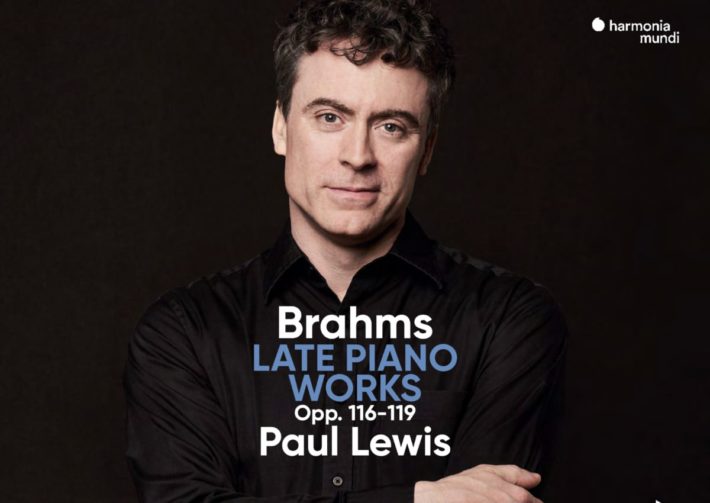Although Brahms deliberately noted that his late piano works (Op. 116-119) were meant as a final say in his compositional career, they do not fade quietly into the night: not only do they show the finest and most mature aspects of his writing but are also surprisingly experimental. Where his earlier output like the three piano sonatas are notable for their sheer magnitude, Op. 116-119, by comparison, are miniatures. However, the weight of these character pieces lies in their profundity–and this can pose an ultimate test of musicianship for any pianist.
Lewis’ Op. 116 gets off to a roaring start with the D minor Capriccio. His measured tempo, steadfast legato, and particular attention to the left-hand movement build a powerful wall of sound. While some might prefer the urgency of, say, Evgeny Kissin’s account from the ’90s (which also benefits from more variety of articulation) Lewis ultimately creates a captivating introduction to the set.
In the A minor Intermezzo (track 2), Lewis seems intent on preserving longer lines but as a result ends up rushing things a bit. The music itself is built upon short phrases with inquisitive endings; this for me calls for a more meditative approach which would allow us to savor the hint of underlying enigma. The A major section, however, offers a delicate brightness that is nicely communicated.
The challenge of the E minor Intermezzo (track 6) is a matter of reconciling the marking (‘with grace and intimate feeling’) with a theme that has a sense of foreboding. Lewis handles this conundrum nicely; the chromatic two-note phrases are indeed graceful but there’s just enough space between them to create the mystery of where each one leads.
Related Posts
- Review: Beethoven – Complete Bagatelles – Paul Lewis, Piano
- Review: Brahms – Clarinet Sonatas – Jörg Widmann, András Schiff
- Review: Brahms – Piano Concerto No. 1 – Moog, Deutsche Radio Philharmonie, Milton
Op. 118 can’t go without a mention of the well-loved A major Intermezzo (track 12). For all of its beautiful writing, it can fall victim to sounding maudlin when not approached sensibly. That is fortunately not the case here. Lewis has an elegant restraint that doesn’t equate to confinement but instead reveals smaller details like lovely dynamic shadings and inner voices (whose importance many performers sadly overlook). The bold G minor Ballade that follows has interpretations aplenty that vary wildly: Kempff (‘60s DG) is deliberate yet dignified with his slower tempo; Lupu (‘70s Decca) keeps the staccatos extra crisp and creates a dancelike lilt; Kovacevich (‘80s Phillips) unleashes a nearly overwhelming fury. Lewis settles for middle ground, bringing out an expansive, stately character. The good voice leading stands out, so much so that we might even perceive the work as a lied: his handling of the staccato chordal textures make them a fitting complement to the well-preserved melodic arc, as well as a means to create convincing surges of intensity where they’re needed.
The E-flat Intermezzo (track 16) is for me one of the composer’s most distinct works of the late opuses: it’s hard to pin a specific personality, especially to the minor sections, which are a mix of poignant lament, undulating mystery, and contemplation. Lewis observes this complexity, even in something as singular as the opening line. While the reference to Dies Irae is not to be missed, he adds an ambiguous sort of haze which sets us in anticipation.
The B minor Intermezzo of Op. 119 (track 17) exemplifies the minimalism that Brahms experimented with in his final years. With chords dissolved into delicate individual threads, what results is an almost otherworldly sheen. Though Lewis’ tone may not be as magical or translucent as Jeremy Denk’s (from his excellent 2019 recording reviewed here), his good pedal control makes up for it to capture the fragility of the lines. The composer’s E-flat major Rhapsody perhaps looks back upon his earlier maximalism but does have its element of surprise: the shift from a jubilant major key to its furious minor counterpart. Lewis grasps this quick change effectively in the final moments while evokes the work’s vibrant, symphonic character.
The sound engineers at Teldex Studios do solid work on this recording, bringing out the music’s most thunderous moments (also thanks to the instrument’s particularly well-regulated bass) as well as its most sensitive. For works as oft-performed as these, the liner notes successfully shed light on the dichotomy of these works as late yet exploratory. While some of the older landmark recordings might still be preferred, this is a solid effort from Lewis overall.

Brahms – Late Piano Works Opp. 116-119
Paul Lewis – Piano
Harmonia Mundi, CD HMM902365
Recommended Comparisons
Read more classical music reviews or visit The Classic Review Amazon store
Follow Us and Comment:
Get our periodic classical music newsletter with our recent reviews, news and beginners guides.
We respect your privacy.









